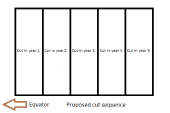
 1
1
























Life that has a meaning wouldn't ask for its meaning. - Theodor W. Adorno




"A society grows great when old men plant trees whose shade they know they shall never sit in."




We recommend planting 1200 trees per acre, which means spacing your trees on 6'x 6' centers. These 10” unrooted Frysville Hybrid Poplar cuttings when planted as early as possible in March thru May will reach heights of five to eight feet by the end of their first summer. By the end of the second growing season they will have reached heights of from 10 to 14 feet and by the end of four years will be approximately 25 to 30 feet high. We suggest the planting of ¼ to ½ acre per year according to your needs with unrooted cuttings. This will be done for four successive years. At the end of four years the trees from the first years planting of ¼ acre will have reached 25 to 30 foot high, should be approximately 4 to 6 inches in caliber and should yield 3 cords of great firewood. On the second and succeeding harvest this same planting will yield five cords. This size is just right without having to split it to fit into your stove.
Anyone who believes exponential growth can go on forever in a finite world is either a madman or an economist.




Life that has a meaning wouldn't ask for its meaning. - Theodor W. Adorno




Dunkelheit wrote:
I wouldn't plant poplar. They are fast growing but without any value. Grow hardwoods, nut trees, honey trees. Stuff that is useful for you even when you don't coppice.
Anyone who believes exponential growth can go on forever in a finite world is either a madman or an economist.





"A society grows great when old men plant trees whose shade they know they shall never sit in."




Life that has a meaning wouldn't ask for its meaning. - Theodor W. Adorno




Dunkelheit wrote:
Paulownia is best when you grow stuff just to burn it. Better heating value than poplar and willow and grows equally fast.
"A society grows great when old men plant trees whose shade they know they shall never sit in."




Dunkelheit wrote:
Paulownia is best when you grow stuff just to burn it. Better heating value than poplar and willow and grows equally fast.
Anyone who believes exponential growth can go on forever in a finite world is either a madman or an economist.








Life that has a meaning wouldn't ask for its meaning. - Theodor W. Adorno




Dunkelheit wrote:
Paulownia is frost resistant after 2 years. Poplar and willow need moist to wet soil.
 My poplars grew about 7' this year and they are on the top of a dry berm. Perhaps they would have done better if the soil hadn't be so dry. They did grow quite slowly the first couple of years but I think that was due to the fact that they had lots of competition from surrounding vegetation. I've found that scything around new tree plantings for the first 3 years helps them compete with the already established vegetation. Once the roots are established, clearing surrounding vegetation doesn't seem so critical.
My poplars grew about 7' this year and they are on the top of a dry berm. Perhaps they would have done better if the soil hadn't be so dry. They did grow quite slowly the first couple of years but I think that was due to the fact that they had lots of competition from surrounding vegetation. I've found that scything around new tree plantings for the first 3 years helps them compete with the already established vegetation. Once the roots are established, clearing surrounding vegetation doesn't seem so critical.Anyone who believes exponential growth can go on forever in a finite world is either a madman or an economist.

|
Too many men are afraid of being fools - Henry Ford. Foolish tiny ad:
The new gardening playing cards kickstarter is now live!
https://www.kickstarter.com/projects/paulwheaton/garden-cards
|







